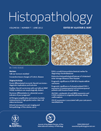
HISTOPATHOLOGY
Scope & Guideline
Bridging Laboratory Insights with Clinical Excellence
Introduction
Aims and Scopes
- Innovative Diagnostic Techniques:
The journal emphasizes the development and application of new diagnostic methods, including molecular pathology techniques, deep learning algorithms, and immunohistochemistry, to enhance the accuracy and efficiency of histopathological diagnoses. - Molecular and Genetic Characterization of Tumours:
A significant focus is placed on the molecular profiling of tumours, exploring the genetic alterations associated with various malignancies, and their implications for treatment and prognosis. - Integration of Clinical and Pathological Insights:
The journal seeks to bridge the gap between clinical findings and pathological interpretations, encouraging studies that correlate histopathological features with clinical outcomes. - Pathological Classification and Staging Systems:
The evolving nature of pathological classification systems is a core area of interest, with an emphasis on the updates in WHO classifications and their impact on diagnostic practices. - Emerging Tumour Entities and Variants:
A consistent focus on identifying and characterizing emerging tumour types and variants, including rare neoplasms, is central to the journal's scope.
Trending and Emerging
- Artificial Intelligence in Histopathology:
There is a growing trend towards the integration of artificial intelligence and machine learning techniques in histopathological analysis, aimed at improving diagnostic accuracy and efficiency. - Molecular Profiling and Precision Medicine:
An increasing emphasis on the molecular characterization of tumours, including the identification of genetic mutations and their implications for targeted therapies, is becoming a significant area of focus. - Tumour Microenvironment Studies:
Research exploring the tumour microenvironment and its role in cancer progression and treatment response is gaining traction, reflecting a holistic approach to understanding neoplasms. - Immunotherapy and Biomarkers:
The investigation of biomarkers associated with immunotherapy responses, particularly in the context of PD-L1 and other immune checkpoint markers, is an emerging theme that underscores the journal's relevance in contemporary oncology. - Interdisciplinary Approaches to Pathology:
There is a trend towards multidisciplinary research that combines pathology with other fields such as genomics, bioinformatics, and clinical research, promoting a more integrated view of cancer diagnostics and treatment.
Declining or Waning
- Traditional Histopathological Techniques:
There is a noticeable decrease in publications centered on classical histopathological techniques, such as routine H&E staining, as newer, more advanced methodologies gain prominence. - Generalized Tumour Types:
The journal has seen a decline in articles discussing well-established tumour types without novel insights or methodologies, as researchers increasingly seek to explore more complex or less commonly addressed entities. - Non-Molecular Pathology Studies:
Studies focusing solely on descriptive pathology without integrating molecular or genetic data are becoming less frequent, indicating a shift towards more comprehensive approaches that include molecular insights.
Similar Journals

APPLIED IMMUNOHISTOCHEMISTRY & MOLECULAR MORPHOLOGY
Advancing knowledge in histology and pathology.Applied Immunohistochemistry & Molecular Morphology, published by Lippincott Williams & Wilkins, stands as a pivotal resource within the fields of histology, medical laboratory technology, and pathology. With an ISSN of 1541-2016 and an E-ISSN of 1533-4058, this journal has been contributing significant research and advancements since its inception in 1996. It serves a diverse audience, including researchers, professionals, and students, aiming to enhance the understanding of immunohistochemical techniques and molecular morphology. Recognized for its quality, it holds category quartiles of Q3 in histology and Q2 in medical laboratory technology and pathology and forensic medicine as of 2023. The journal's rigorous peer-review process ensures that only the most impactful findings are disseminated, thus advancing the education and practice in these critical domains of study. Though it is not an open-access journal, it remains essential for keeping abreast of the latest methodological innovations and applications in pathology and laboratory science, as evidenced by its respectable Scopus rankings and the continual convergence of groundbreaking research published through 2024.
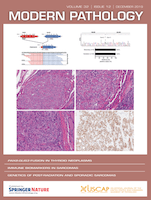
MODERN PATHOLOGY
Leading the Way in Pathological ResearchMODERN PATHOLOGY is a premier journal in the field of pathology and forensic medicine, published by Elsevier Science Inc. With an impressive impact factor that places it in the top 1st quartile (Q1) for 2023, and a remarkable rank of 5 out of 208 in its category according to Scopus, it serves as a vital resource for researchers, professionals, and students alike. Established in 1988, the journal focuses on the latest advancements in diagnostic pathology, molecular pathology, and related fields, providing a platform for innovative research that drives the discipline forward. Although it does not operate under an open access model, readers can expect rigorously peer-reviewed publications that contribute to the growing body of knowledge in pathology. With a continuous commitment to excellence and relevance, MODERN PATHOLOGY remains a fundamental avenue for disseminating high-quality scientific research globally, facilitating the growth and development of its field.

ENDOCRINE PATHOLOGY
Connecting Research and Clinical Excellence in EndocrinologyENDOCRINE PATHOLOGY is a premier journal published by HUMANA PRESS INC, dedicated to advancing the understanding of endocrine disorders through innovative research and clinical practices. With an impressive impact factor and consistently ranked in the Q1 quartile across multiple categories such as Endocrinology, Diabetes and Metabolism, as well as Pathology and Forensic Medicine, this journal serves as a pivotal resource for researchers and professionals in the field. The journal covers a broad spectrum of topics related to endocrine pathology, providing insights into mechanisms, diagnostics, and therapeutics that inform both clinical and laboratory practices. Although it does not offer open access, its rigorous peer-review process ensures the dissemination of high-quality, impactful research that shapes clinical strategies and enhances patient care. With distribution spanning from its inception in 1990 to 2024, ENDOCRINE PATHOLOGY stands at the forefront of endocrine research, making it an essential read for anyone involved in the study and treatment of endocrine disorders.

Pathologie
Fostering Excellence in Pathology Research and PracticePathologie is a distinguished academic journal published by Springer Heidelberg, dedicated to advancing the field of pathology and forensic medicine. With an ISSN of 2731-7188 and an E-ISSN of 2731-7196, this journal serves as a vital platform for researchers, professionals, and students to disseminate innovative findings and insights. Currently ranked in the Q3 category of pathology and forensic medicine according to the 2023 metrics, Pathologie reflects a commitment to quality and relevance in a dynamic research landscape. Despite its relatively recent establishment from 2022, the journal is gaining traction with a Scopus rank of 139 out of 208 in its category, positioning itself as an emerging resource within the academic community. While it operates under a subscription model, the importance of the journal lies in its objective to facilitate the exploration of diverse pathological processes and enhance forensic methodologies, ultimately improving clinical outcomes and investigative practices. As it continues to grow, Pathologie stands poised to impact the pathology domain significantly.
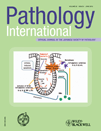
PATHOLOGY INTERNATIONAL
Exploring the Depths of Pathological SciencePATHOLOGY INTERNATIONAL, published by WILEY, stands as a distinguished journal in the field of pathology and forensic medicine, serving as an essential resource for researchers, clinicians, and students alike. With its ISSN 1320-5463 and E-ISSN 1440-1827, PATHOLOGY INTERNATIONAL has established itself since its inception in 1951, navigating through an evolving landscape in medical science with insights and breakthroughs up to 2024. It holds a commendable Q2 ranking in both the Medicine (miscellaneous) and Pathology and Forensic Medicine categories, indicating its robust influence and quality within these fields, as evidenced by its placement in the 70th percentile of Scopus rankings. While currently not an open-access journal, it provides access options that ensure valuable research remains available to the academic community. PATHOLOGY INTERNATIONAL commits to advancing the discipline through pioneering research articles, comprehensive reviews, and expert opinions that push the boundaries of understanding in pathology, thereby supporting the enhancement of diagnostic and therapeutic practices.
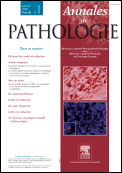
ANNALES DE PATHOLOGIE
Pioneering Knowledge in Pathology Since 1981ANNALES DE PATHOLOGIE, published by MASSON EDITEUR, stands as a pivotal resource in the field of pathology and forensic medicine, delivering critical insights since its inception in 1981. With an emphasis on advancing understanding and research applications within these domains, the journal is positioned to cater to a diverse audience of researchers, healthcare professionals, and students alike. While currently classified in the Q4 category within the pathway of Pathology and Forensic Medicine, it remains committed to fostering scholarly contributions and innovative research that contribute to the field's growth. Although it does not offer Open Access options, its print and electronic ISSNs (0242-6498 and 2213-008X) ensure availability for readership across global institutions. The Scopus ranking highlights its niche relevance, with a current rank of #189 out of 208 in its category, indicating a promising trajectory for future research endeavors. Published in France, ANNALES DE PATHOLOGIE invites contributions that engage the academic community and advance knowledge in pathology's most pressing matters.
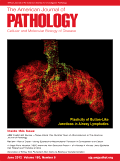
AMERICAN JOURNAL OF PATHOLOGY
Connecting Research and Practice in Pathology ExcellenceAmerican Journal of Pathology, published by Elsevier Science Inc, is a premier academic journal that has significantly contributed to the field of pathology since its inception in 1946. With an ISSN of 0002-9440 and an E-ISSN of 1525-2191, this esteemed journal is recognized for its rigorous peer-review process and high-quality research publications. Currently classified in the Q1 quartile of the Pathology and Forensic Medicine category, it ranks impressively at #9 out of 208 in Scopus, positioning it within the top 5th percentile of journals in its field. The American Journal of Pathology serves as a vital resource for researchers, clinicians, and students, offering cutting-edge insights and critical research findings that drive advancements in diagnostic and therapeutic strategies. As a non-open access journal, it ensures the dissemination of high-quality content while maintaining a dedicated subscriber base. With a commitment to excellence, this journal is an essential platform for anyone involved in pathology and forensic studies, paving the way for innovative research that addresses the complex challenges within the medical field.

Turkish Journal of Pathology
A Vital Resource for Pathology Professionals WorldwideTurkish Journal of Pathology, published by the Federation Turkish Pathology Society, stands as a vital platform for disseminating high-quality research in the field of pathology and forensic medicine. With an ISSN of 1018-5615 and an E-ISSN of 1309-5730, this journal has been an open-access publication since 2013, ensuring that cutting-edge findings are readily available to the global community. Based in Turkey, it aims to contribute significantly to the advancement of pathology as it converges from 2010 to 2024, currently holding a Q3 quartile ranking in its category according to 2023 metrics. As it ranks #129 out of 208 in the Scopus database for Medicine, Pathology, and Forensic Medicine, it offers researchers, professionals, and students invaluable insights and innovative studies that address critical developments in the field. The Turkish Journal of Pathology fosters collaboration and knowledge-sharing, making it an essential resource for anyone involved in pathology research and practice.

HISTOLOGY AND HISTOPATHOLOGY
Fostering Insights into Tissue Structure and FunctionHISTOLOGY AND HISTOPATHOLOGY, published by F HERNANDEZ, is an esteemed academic journal dedicated to advancing the fields of histology and pathology. With its ISSN 0213-3911 and E-ISSN 1699-5848, this journal has been a crucial resource for researchers and professionals since its inception in 1986. The journal enjoys a strong reputation, evidenced by its Q2 category rankings in both Histology and Pathology & Forensic Medicine as of 2023, positioning it within the top tier of scholarly publications. With Scopus rankings placing it at Rank #74/208 in Medicine - Pathology and Forensic Medicine and Rank #31/62 in Medicine - Histology, it proves to be an essential platform for disseminating significant research findings and innovations. Although the journal is not open access, it is committed to providing high-quality, peer-reviewed articles that cater to the needs of its academic community. With a focus on fostering a deeper understanding of tissue structure and disease mechanisms, HISTOLOGY AND HISTOPATHOLOGY serves as an indispensable resource for students, researchers, and practitioners alike, facilitating the exchange of knowledge and pioneering research in these vital areas of study.

Diagnostic Pathology
Transforming Medical Science with Accessible ResearchDiagnostic Pathology is a prominent open-access journal published by BMC, dedicated to advancing the field of pathology by providing a platform for high-quality research findings since its inception in 2006. Based in the United Kingdom, the journal covers a broad spectrum of topics within the realms of histology, pathology, and forensic medicine, facilitating discussions that are crucial for both clinical and laboratory settings. With an impressive impact factor that places it in the Q2 category across multiple categories including Histology and Miscellaneous Medicine, it ranks favorably in Scopus with notable positions in the 71st and 55th percentiles for Pathology and Histology respectively. As a valuable resource for researchers, professionals, and students alike, Diagnostic Pathology promotes the dissemination of cutting-edge studies and findings, thereby contributing significantly to the evolving landscape of medical science. The journal’s commitment to open access enhances its accessibility, ensuring that valuable research is freely available to a global audience.